scientific delirium madness gallery 1.0
introduction
by Margot H. Knight
Djerassi Resident Artists Program Executive Director
JONAS SALK
Charlotte DeCroes Jacobs
Email: cjacobs@stanford.edu.
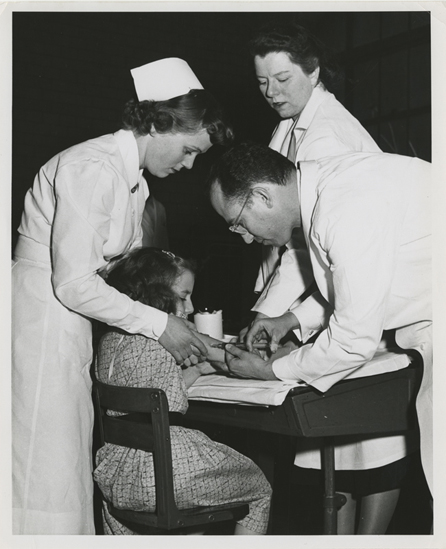
(Image courtesy of Jonas Salk Papers, Mandeville Special Collections and Archives, UC San Diego)
ON 12 APRIL 1955, WHEN THE WORLD learned that Jonas Salk’s vaccine could prevent poliomyelitis, he became an international hero overnight. Revered by the public, he was snubbed by the scientific community---the one group whose praise he craved.
Salk’s historic role in preventing polio overshadowed his part in co-developing the first influenza vaccine, his pioneering work on AIDS, and his efforts to meld the sciences and humanities in the Salk Institute. It is this latter part of Salk’s life that I focused on during Scientific Delirium Madness.
Jonas Salk all but eradicated polio from the face of the Earth, and the scientific community never forgave him.
In 1959, Sir C.P. Snow’s “The Two Cultures” became Salk’s bible. Salk agreed that literary intellectuals and scientists rarely communicated, and when they did it was often adversarial. Lawmakers rarely considered scientific implications when setting public policy; scientists didn’t necessarily consider mankind’s well being in their research endeavors. “I felt there ought to be a place,” Salk said, “for biological studies but which also contained the conscience of man.” Searching for a site whose natural beauty stimulated harmony, he chose La Jolla, California, where Louis Kahn built an architectural masterpiece. Although the Salk Institute is considered one of the premier research institutes, Salk felt sad that in the end science trumped humanism at his beloved Institute.
As I interacted with the resident artists and scientists during Scientific Delirium Madness, sharing the creative process and witnessing collaborations, I thought about Salk’s dream. As a physician and biographer, I am grateful to the Djerassi Resident Artists Program (DRAP), the Patricia E. Bashaw and Eugene Segre Fellowship, and Leonardo for their efforts to blend the two cultures. That month I could sense Jonas Salk walking between the Artist’s Barn and Middlebrook Writing Studios saying, “Yes, this is what I was striving for.”
JONAS SALK was released by Oxford University Press in May 2015.
Chromaticity
Curtis W. Frank
Email: Curt.frank@stanford.edu.
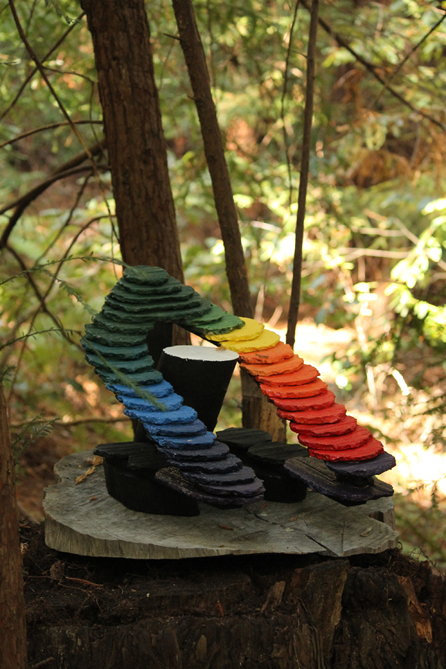
Curtis W. Frank, Chromaticity, painted cast-off roof tiles and items from a woodpile found on the premises of the Djerassi Resident Artists Program, 2014. (Photo: Celia Olsen)
MY PATH TO SCIENTIFIC DELIRIUM MADNESS in the Djerassi Resident Artists Program (DRAP) began with an introductory sophomore seminar called “Art, Chemistry and Madness: The Science of Art Materials” that I have taught at Stanford University for the past 8 years. This course includes my lectures on the materials science of objects of art, studio lab activities led by my co-instructor Sara Loesch-Frank and behind-the-scenes access to the collection of the Cantor Arts Center with conservator Susan Roberts-Manganelli. I went “up on the mountain” intending to design a text that could teach the principles of materials science through examples provided by objects of cultural heritage. During the first two weeks of my “Gift of Time,” I concentrated on the book and on reading John Gage’s work on color theory that, prior to my time as a resident at Djerassi, had not risen high enough in priority. One of the topics that caught my attention was the CIE chromaticity scale developed in 1931 as a quantitative standard for industrial lighting. I became captivated by the possibility of abstracting this lighting standard in some physical way. I began by digging through various piles of “stuff” on the DRAP property and collected some cast-off roof tiles and items from the woodpile. Working from the two-dimensional figure representing the lighting standard, I designed a three-dimensional object that captures some of the critical elements. The result is Chromaticity. The colors of the disks represent the fully saturated Newtonian colors, the heights of disks are related to the sensitivity of the human eye to visible light and the centrally located white oval represents the zone where appropriate combinations of colors mix to white. I had no idea that my month would lead to this.
Bridging Dance and Science
Donna Sternberg
Email: dsdancers@earthlink.net.
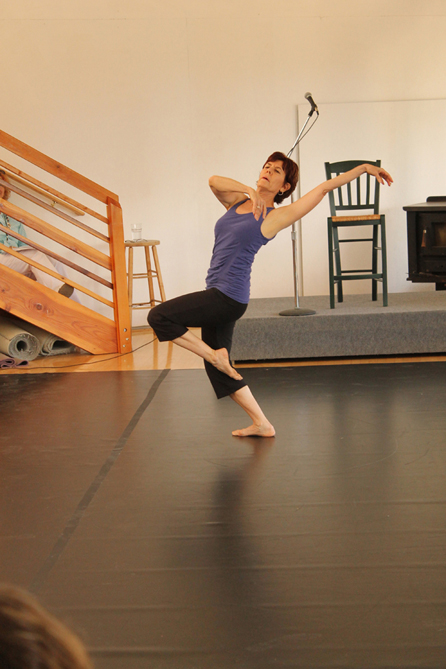
Donna Sternberg performing during the Djerassi Open House, 27 July 2014. (© Donna Sternberg)
I AM PASSIONATE ABOUT DISCOVERY and interested in the “big questions” that deal with the human experience. I use science as a framework to give shape and structure to my artistic explorations, drawing parallels and metaphors between science and human behavior.
I went to Djerassi with a few projects in mind, but in the end I found that the interactions with the other residents informed and directed the work that I did, both in planned and new projects. From casual conversations to substantive discussions about the viability and desirability of art/science projects, these interactions brought forth questions and inspiration for continuing my own journey of bridging dance and science. While attending a poetry reading by fellow resident Pireeni Sundaralingam, I was captivated by the imagery of her poem “Mussels” and inspired to choreograph to it, incorporating music by resident composer Ari Frankel. This initial collaboration has flowered into a performance of dance, poetry and music that will take place in the fall of 2015 in Culver City, CA. It will also investigate how the process of collaborating across different art forms affects the artists involved on a cognitive level.
Artist Meredith Tromble and scientist Dawn Sumner were working on a 3D project that offered myriad possibilities for a dance component. Along with physicist Jim Crutchfield, who was also affiliated with the project, we discussed a collaboration that would expand the project to include dance and video.
Fellow resident immunologist Devavani Chatterjea expressed an interest in collaborating on a dance based on immunology. I asked Devavani to give me some principles we could explore and she provided me with several scenarios that were ripe with imagery and movement possibilities. We have plans to develop the project incorporating dialogue between Devavani’s students and the dancers in the conceptual and creative process.
RE(TIME)
Sasha Petrenko
Email: sashpetrenko@gmail.com.
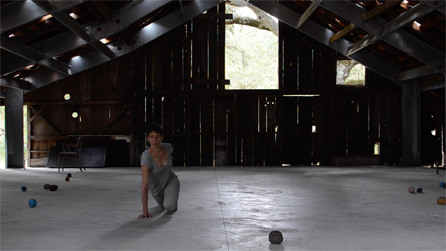
Sasha Petrenko performing scene 3 of (RE)TIME, 2014, a dance-play in development about human+nature relationships. (Image courtesy of the artist)
I HAD PLANNED TO USE MY TIME at Djerassi to write a choral piece about hydraulic fracturing for my play Clinging to a Rock Hurtling Trough Space. At the time I did not know the play would be called that. I did not know a lot of things.
I began by reading EPA reports, editorials and propaganda both for and against hydraulic fracturing. I found maps and deeds relating to the brief La Honda oil boom of the 1920s. After discovering the location of local wells, I took a field trip. But my navigational skills and Google maps were both spotty, and the resulting experience left me feeling lost on a number of levels.
Then something told me “let the land lead you . . . ”
As a by-product of my fracking research I began noticing geologic phenomena all around. Geologic time, thousands and millions of years, were visible in layers I could touch and feel. I felt like I’d found something truly profound.
From this experience I developed (RE)TIME, a 20-minute performance with sound spanning all of geologic time from the planet’s birth, through several mass extinctions, up until the present day. Throughout the piece I move a small, blue sphere---representing Earth---upstage, along an imagined geologic timescale toward the audience.
In the final seconds of the performance we arrive at our current geologic era, identified by significant human influence on the Earth’s lithosphere, hydrosphere and atmosphere. As the scene ends I’m stretched out on the floor reaching towards the audience and the blue sphere just out of my reach. There is stillness and silence, followed by a reading of Devavani Chatterjea’s poem “The Gift” by another performer.
To learn more about Clinging to a Rock Hurtling through Space, visit <www.sashapetrenko.org>.
Dream Vortex
Meredith Tromble and Dawn Sumner
Email: mtromble@sfai.edu and dysumner@gmail.com.
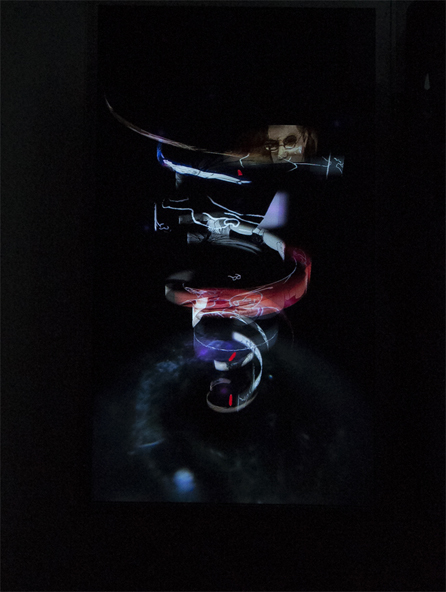
Meredith Tromble and Dawn Sumner, still from Dream Vortex, interactive, 3D, mixed-reality art installation consisting of dreams, conversations, mixed-media drawings and programming, 2011--, dimensions variable. Dream fragments circulating in the Dream Vortex. (© Meredith Tromble and Dawn Sumner)
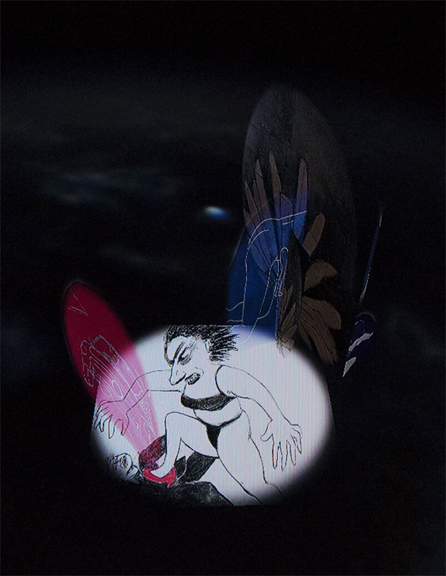
Meredith Tromble and Dawn Sumner, still from Dream Vortex, interactive, 3D, mixed-reality art installation consisting of dreams, conversations, mixed-media drawings and programming, 2011--, dimensions variable. The dream drawing Red Convertible is playfully arranged to become “blood” spurting from the drawing Monster Stomping on My Husband, as other dreams lurk in the background. (© Meredith Tromble and Dawn Sumner)
DREAM VORTEX IS AN INTERACTIVE, 3D, mixed-reality art installation, based on dreams collected from a visualization research community and developed for a CAVE, Oculus Rift or 3D monitor we (artist Meredith Tromble and scientist Dawn Sumner) began developing in 2011. Drawings of dream scenarios circulate in a vortex, accompanied by an abstract sound environment. A viewer interacts with the vortex by selecting dream emblems with a game controller. Once a dream is selected, the vortex disappears; the chosen dream and a suite of related dreams come into view. For the time span of a typical dream (a few minutes) the viewer can interact with them, moving, resizing and arranging them in new patterns, subject to a dream-appropriate degree of surprising, random change built into the programming. Then the vortex reappears and a new cycle begins. Dream Vortex, a collaboration between an artist and a scientist, dissolves the boundaries between seemingly opposite activities. It unites humanity’s oldest and newest image-making technologies---charcoal drawing and programming---and brings subjective questions into an objective research environment. It is also a beautiful visual and aural experience, a harbinger of the new art forms that will emerge as 3D tools become widely available to artists.
Pulse, Impulse
Pireeni Sundaralingam
Email: pireenis@yahoo.com.

Pireeni Sundaralingam, Pulse, Impulse, multimedia installation: wood, steel, acrylic paint, 2014. (© Pireeni Sundaralingam)
I AM INTERESTED IN MAKING VISIBLE the invisible, particularly with reference to the mysteries of the human nervous system and the ways in which we perceive the world. I am particularly fascinated by the question of how our cognition and nervous systems mediate the way we understand and explore the space around us, and I have pursued these ideas through my training as a cognitive scientist and as a creative writer. The Scientific Delirium Madness residency allowed me the time and freedom to investigate these ideas through many further channels, including installation work.
My piece Pulse, Impulse was inspired by two elements: firstly, the intersecting nature of the dialogue between the 12 artists and scientists gathered together during the residency; and, secondly, the desire to bring into relief the physical nature of our respective nervous systems.
Each wooden rod in this installation is the exact length of the longest nerve cell (the sciatic nerve) measured from the body of a particular artist or scientist at the residency. The brushed steel coils used at each node of the installation is a metaphoric representation both of synapses and of the spark of dialogue between thinkers.
Updated 31 August 2015

